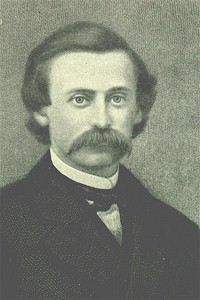Henry Timrod
Henry Timrod, December 8, 1828 - October 7, 1867, was called The Poet Laureate of the Confederacy by famed Victorian era poet Alfred Lord Tennyson. He was born in Charleston, South Carolina to a family of German descent—the family's original surname was "Dimroth." His father was an officer in the Seminole Wars and a poet himself. Timrod studied at the University of Georgia, but, forced by illness to end his formal studies, returned to Charleston. He took a position with a lawyer and planned to begin a law practice.
From 1848 to 1853 he submitted a number of poems to The Southern Literary Messenger, under the pen name Aglaus, where he attracted some attention for his abilities. Encouraged, he left the field of law for writing and tutoring.
In 1856 he accepted a post as a teacher at the plantation of Col. William Henry Cannon in the area that would later become Florence, South Carolina. The single room school building (still preserved in Timrod Park in Florence) was built to provide for the education of the plantation children. Among his students was the young lady who would later become his bride and the object of a number of his poems - the fair Saxon Katie Godwin.
preserved in Timrod Park, Florence, South Carolina
While teaching and tutoring he continued also to publish his poems in literary magazines. In 1860, he published a small book, which, although a commercial failure, increased his fame. The best known poem from the book was A Vision of Poesy.
With the outbreak of war, Henry returned to Charleston, soon publishing his best known poems, which drew many young men to enlist in the service of the Confederacy. His best known poems of the time are Ethnogenesis, A Call to Arms, Carolina, and Katie. He was a frequent contributor of poems to Russell's Magazine and to The Southern Literary Messenger.
Timrod soon followed into the military, but illness prevented much service, and he was sent home. After the bloody Battle of Shiloh, he tried again to live the camp life as a western war correspondent for the Charleston Mercury, but this too was short lived as he was not strong enough for the rugged task.
He returned from the front and settled in Columbia to become associate editor of the newspaper, The South Carolinian. In February 1864 he married his beloved Katie, and soon had a son, Willie, born on Christmas Eve. During the occupation by General Sherman's troops in February 1865, he was forced into hiding, and the newspaper office was destroyed.
The aftermath of war brought his family poverty and to him, increasing illness. He took a post as correspondent for a new newspaper based in Charleston, The Carolinian, but after several months of work, he was never paid, and the paper folded. His son Willie soon died, and Henry was to join him in death, of consumption in 1867.
Timrod's friend and fellow poet, Paul Hamilton Hayne, posthumously edited and published The Poems of Henry Timrod, with more of Timrod's more famous poems in 1873, including his Ode: Sung on the Occasion of Decorating the Graves of the Confederate Dead at Magnolia Cemetery, Charleston, S.C., 1867 and The Cotton Boll.
Later critics of Timrod's writings, including Edd Winfield Parks and Guy A, Cardwell, Jr. of the University of Georgia, Jay B. Hubbell of Vanderbilt University, and Christina Murphy, who completed a Ph.D. dissertation on Timrod at the University of Connecticut have indicated that Timrod was one of the most important regional poets of nineteenth-century America and one of the most important Southern poets. In terms of achievement, Timrod is often compared to Sidney Lanier and John Greenleaf Whittier as poets who achieved significant stature by combining lyricism with a poetic capacity for nationalism. All three poets also explored the heroic ode as a poetic form.
Today, Timrod's poetry is included in most of the historical anthologies of American poetry, and he is regarded as a significant—though secondary figure—in nineteenth-century American literature.
In 1901, a monument with a bronze bust of Timrod was dedicated in Charleston, SC. But perhaps the greatest honor paid to him by his fellow patriots was in 1911, when the General Assembly passed a resolution instituting the verses of his poem, "Carolina," as the lyrics of the official state anthem.
Bob Dylan, a major figure in popular music, included numerous references to various Timrod poems on his 2006 CD Modern Times.
See also
- Ode: Sung on the Occasion of Decorating the Graves of the Confederate Dead at Magnolia Cemetery, Charleston, S.C., 1867
- Cisco, Walter Brian, Henry Timrod: A Biography, Fairleigh Dickinson University Press, 2004, ISBN 0-8386-4041-9.
External links
- Faint Falls the Gentle Voice of Prayer -A prayer for peace penned by Timrod after seeing the horrors of war (words and audio)
- Works by Henry Timrod. Project Gutenberg
Credits
New World Encyclopedia writers and editors rewrote and completed the Wikipedia article in accordance with New World Encyclopedia standards. This article abides by terms of the Creative Commons CC-by-sa 3.0 License (CC-by-sa), which may be used and disseminated with proper attribution. Credit is due under the terms of this license that can reference both the New World Encyclopedia contributors and the selfless volunteer contributors of the Wikimedia Foundation. To cite this article click here for a list of acceptable citing formats.The history of earlier contributions by wikipedians is accessible to researchers here:
The history of this article since it was imported to New World Encyclopedia:
Note: Some restrictions may apply to use of individual images which are separately licensed.

